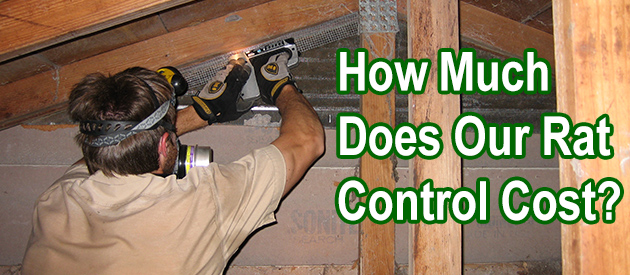Alameda County, Oakland Rat Control Situation:
I read your website on safe removal of rats and sealing up the entry. Could you answer some more questions on this topic? Several weeks ago, I discovered that I had a rat problem in the backyard. I thought the fancy tricks would work. They did not. Still have the rats. They are eating the dogs food and drinking their water. Thankfully, the dogs are vaccinated. I called the exterminator who had to put out poison in a secure area. Its been a few days over a week and I do not see or hear rats outside. Thought we were good! But, now I hear scratching, or chewing in the kitchen wall. Yes. IN the wall. I am freaked out! I did buy a cat (which I am allergic too, but in desperate times we take desperate measures.) I thought she could take care of anything that might happen ( I know these damn rats can eat through anything!) They ate through the dogs plastic bucket where their food was held. I have two small children. I am concerned for their safety. Who do I call to look for entries into the house? How will they seal the entries? I think it is under the siding. Years ago, I had the bottom siding replaced. I think they did not do a good job, so things are getting in..under and up. How will an exterminator get these rats out of the wall??? I am scared...for my kids...for me...for my house getting ruined. I just got laid off (at the end of the school year because of budget cuts ... I am a special education teacher). Can you offer advise on this. I am not sure what to do. Thanks.
My response: Rats in the wall isn't a big deal. They won't get you sick or anything. But as I've said on my website, you have to inspect the house and find out how the rodents are getting inside. Seal up every single last entry/exit hole and gap with steel. Trap, properly trap on rat runways, ALL the rats, and remove them from the house. If they are STUCK down a wall, you will have to cut a hole in the wall to remove them. But it's rare that they get stuck. As far as finding those entry holes, it's not always easy. Where do you live?
Wow! Rats in the wall not a big deal is NOT what I thought you would say. Sort of happy about that, really. I live in Oakland CA. I did look on your website for wildlife removers and did find a company you listed that handles these matters. I called them first thing this morning and left a message requesting their suppport. My questions are: 1. How will they get them out of the WALL???? I can hear them chewing and scratching. It is right next to two outlets (on either side of the wall). I worry that they will eat the electrical wire and cause a fire. I also worry that they will eat through the dry wall and come into the house (hence the cat...she knows her job). 2. Who do I call to fix the entry way problem that is allowing these pests to get in? 3. Am I in for a huge mess...and expense? 4. Is there a way to make the rats gone forever? I can deal with snakes, spiders, scorpions and mice, but rats are a whole different issue. Thanks for your reply. I sure do appreciate the support. In service, Judy
My response: I don't know what else to say. It's not a hard job. Very standard. Your wildlife company has to find out how they are getting in, and seal those ares shut with steel. Unless the rats are stuck in the wall, it's a normal job. If they are stuck, your wildlife company cuts a hole and fixes it afterward. The rats are gone forever once the entry holes are all sealed.
Oakland Rat Control Tip of The Week
Why Do Rats Chew On Wires?
Insulation, wires, straw, cardboard, paper, and different materials assist rodents with survival because they can utilize any of those things to build bigger homes, hone their teeth, and more.
Rats find it a lot simpler to chew wires, cable, wood, and even water warming pipes than most other materials because of their teeth. The chewing of wires and cables by rats has been identified as one of the main sources of blackouts in some homes. Out of these materials, wires appear to be the most attractive to rats and mice.
Why Do They Chew On Wires?
Let's review the most common issues relating to rats chewing on wires that some homeowners face every day:- Rodents don't go around searching for wires to chew on. They happen to get a kick out of the chance to stow away in places where other shrouded things are commonly found, for example, your home electric and security wiring system.
- One thing with wires is that they are all over the place, and rats have a nature to follow anything they can bite to keep their teeth from over developing. If they don't bite on wires, they will, in the long run, bite on everything else: glass, plastic, elastic, wood, aluminum, rock, and even concrete.
- Even though rats can chew anything, they love wire more when it comes to grinding their teeth. They can hold the wire as they chew, giving them more control. As you most likely know, rats and mice have sharp teeth, which keep growing unless they find a way to control the growth. This is why they choose wires.
- Keep in mind that rats and mice don't just chew on house wires. They also chew vehicle wires.


